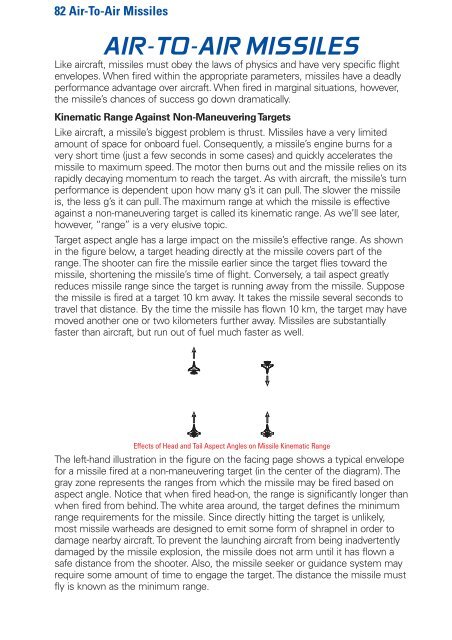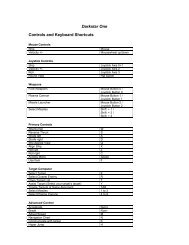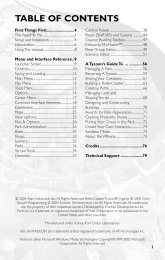Heads-Up Display Modes 35 - Metaboli
Heads-Up Display Modes 35 - Metaboli
Heads-Up Display Modes 35 - Metaboli
You also want an ePaper? Increase the reach of your titles
YUMPU automatically turns print PDFs into web optimized ePapers that Google loves.
82 Air-To-Air Missiles<br />
AIR-TO-AIR MISSILES<br />
Like aircraft, missiles must obey the laws of physics and have very specific flight<br />
envelopes. When fired within the appropriate parameters, missiles have a deadly<br />
performance advantage over aircraft. When fired in marginal situations, however,<br />
the missile’s chances of success go down dramatically.<br />
Kinematic Range Against Non-Maneuvering Targets<br />
Like aircraft, a missile’s biggest problem is thrust. Missiles have a very limited<br />
amount of space for onboard fuel. Consequently, a missile’s engine burns for a<br />
very short time (just a few seconds in some cases) and quickly accelerates the<br />
missile to maximum speed. The motor then burns out and the missile relies on its<br />
rapidly decaying momentum to reach the target. As with aircraft, the missile’s turn<br />
performance is dependent upon how many g’s it can pull. The slower the missile<br />
is, the less g’s it can pull. The maximum range at which the missile is effective<br />
against a non-maneuvering target is called its kinematic range. As we’ll see later,<br />
however, “range” is a very elusive topic.<br />
Target aspect angle has a large impact on the missile’s effective range. As shown<br />
in the figure below, a target heading directly at the missile covers part of the<br />
range. The shooter can fire the missile earlier since the target flies toward the<br />
missile, shortening the missile’s time of flight. Conversely, a tail aspect greatly<br />
reduces missile range since the target is running away from the missile. Suppose<br />
the missile is fired at a target 10 km away. It takes the missile several seconds to<br />
travel that distance. By the time the missile has flown 10 km, the target may have<br />
moved another one or two kilometers further away. Missiles are substantially<br />
faster than aircraft, but run out of fuel much faster as well.<br />
Effects of Head and Tail Aspect Angles on Missile Kinematic Range<br />
The left-hand illustration in the figure on the facing page shows a typical envelope<br />
for a missile fired at a non-maneuvering target (in the center of the diagram). The<br />
gray zone represents the ranges from which the missile may be fired based on<br />
aspect angle. Notice that when fired head-on, the range is significantly longer than<br />
when fired from behind. The white area around, the target defines the minimum<br />
range requirements for the missile. Since directly hitting the target is unlikely,<br />
most missile warheads are designed to emit some form of shrapnel in order to<br />
damage nearby aircraft. To prevent the launching aircraft from being inadvertently<br />
damaged by the missile explosion, the missile does not arm until it has flown a<br />
safe distance from the shooter. Also, the missile seeker or guidance system may<br />
require some amount of time to engage the target. The distance the missile must<br />
fly is known as the minimum range.















